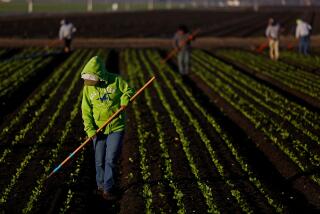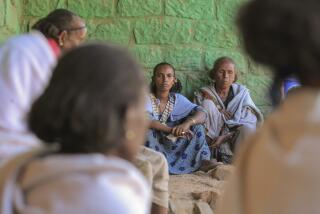Afghanistan on a Long Road Back to Farming
- Share via
SHOMALI PLAIN, Afghanistan — The mines have been cleared from Noor Rahman’s tiny vineyard, and water again flows through the centuries-old irrigation system destroyed by the Taliban regime. But four years of patient nurturing of his desiccated vines lie ahead before Rahman will be able to harvest a single grape.
Undaunted, the impoverished farmer -- who recently returned from six years in exile -- says he feels nothing but joy to be back home working his land, 15 miles north of the Afghan capital, Kabul. He is resigned to doing menial outside jobs until his farm can support his family again.
“There wasn’t a day I was in Iran that I didn’t think about my farm. We were looked on as aliens there. Here we have peace, our own home, and life will get better, God willing,” said Rahman, 35, as he hoed the earth around his surviving vines, a fraction of the 120 that once produced 3 tons of table grapes a year.
Agriculture is just one aspect of life in Afghanistan left in shambles by two decades of war. But the implications of the country’s devastated farming sector are especially insidious and far-reaching. As a result, the success of returning farmers like Rahman has become a top priority of the government and of international aid agencies.
Once an exporter of half a billion dollars’ worth of fruits and nuts -- and self-sufficient in livestock and grains -- Afghanistan has been turned into a nation of subsistence by a combination of war and drought. Excluding illegal opium, it exports no agricultural products to speak of except a small quantity of animal skins, so it has lost the foreign exchange that those goods once generated.
A nation that was once famous for its exports of pomegranates, dried fruits, soft-shell almonds and pistachios now must import those items to feed itself. Its supply of livestock is 40% of what it was a decade ago.
Farmers like Rahman who tilled the soil of the Shomali plain fled the country because the Taliban made farming impossible.
The plain had become a primary battlefront, so the regime cut down orchards, mined fields and blew up irrigation canals to not simply discourage farming but to depopulate the region. Anyone who stayed was hit by a four-year shortage of rainfall that ended only this spring.
After the U.S.-led coalition defeated the Taliban in late 2001, Rahman and others returned to find that what once was an Eden of fruit trees, vineyards and wheat fields had become a wasteland of bombed-out farmhouses and scorched earth.
The loss of agriculture is serious for any country but especially for Afghanistan, where four-fifths of the prewar population lived in the countryside. Now this struggling nation is dealing with the consequences, including massive population migration from rural areas to Kabul and other cities.
These days, partly because farm output is scarce and inefficient, Afghans spend a disproportionate amount of time and resources just trying to feed themselves. What’s more, Rahman and other farmers have forgotten what few modern growing methods they once knew.
International authorities are concerned that farmers who can’t make a go of traditional farming because of shattered infrastructure will turn to the cultivation of poppies for opium production.
Harvests of poppy gum, the raw material for heroin, reached more than 4,000 tons in 2002 -- enough to supply a huge share of the world’s addicts.
Like everyone else here, farmers need international help. Despite the determination of men like Rahman, the picture is gloomy enough that it prompted the United Nations Food and Agriculture Organization to issue a warning Thursday that “long-term agricultural development activities in Afghanistan are under threat unless urgently needed donor funds are provided.”
Manfred Staab, the FAO’s program manager for Afghanistan, said agricultural support programs face a funding shortfall of about $25 million.
In concert with the Italian government, a team of FAO experts is pushing a two-pronged aid program for farmers, one that resembles programs offered to U.S. farmers by state universities.
One facet involves giving farmers short-term help in raising cash crops such as vegetables, while a parallel initiative offers longer-term assistance to help them bring orchards and fields back to life.
Rahman and his neighbors are now receiving irrigation water because of the Italian team’s rehabilitation of a nearby canal system that had filled with silt and, in some sections, was blown up by the Taliban.
But there is much more to be done, in part because local farmers are decades behind in farm technology.
The chaos of war had much to do with that, as did the fact that Afghan farming methods were primitive to begin with, said Giuliano Finetto, an Italian horticultural expert heading a special FAO outreach program here.
“Farming conditions now are very backward here. You could say archaic. Many Afghan farmers are using plowing techniques that haven’t been seen in Europe since the 17th century,” Finetto said.
The lack of basic know-how, such as how to prepare land for planting, means that only 50% of seeds sown end up germinating, he said.
Farmers are also at an acute disadvantage in growing crops efficiently because the average size of farms is just four acres, meaning few farmers can achieve economies of scale. So more cooperative farming is needed, Finetto said.
Decades of war have meant that much of the country’s valuable farm knowledge has been lost, even the names of varieties of grapes that grow best in Afghanistan, said Raffaele Del Cima, another FAO expert from Italy working here. Many successful farmers and agronomists left Afghanistan for other countries and aren’t likely to come back, he said.
“There is an agricultural school at the university here, but it is not cutting-edge,” Del Cima said.
His team is trying to rehabilitate an experimental farm west of Kabul where 52 varieties of grapes were once raised. It was abandoned during the war.
“We are trying to assess which varieties are the most promising,” Del Cima said. “But we are starting from zero.”
Still, as bleak a landscape as the experts paint, Rahman can barely contain his optimism.
“One’s homeland is better than any other country. Even when Afghans have nothing, they wait for God,” he said. “All the time.”
More to Read
Sign up for Essential California
The most important California stories and recommendations in your inbox every morning.
You may occasionally receive promotional content from the Los Angeles Times.










